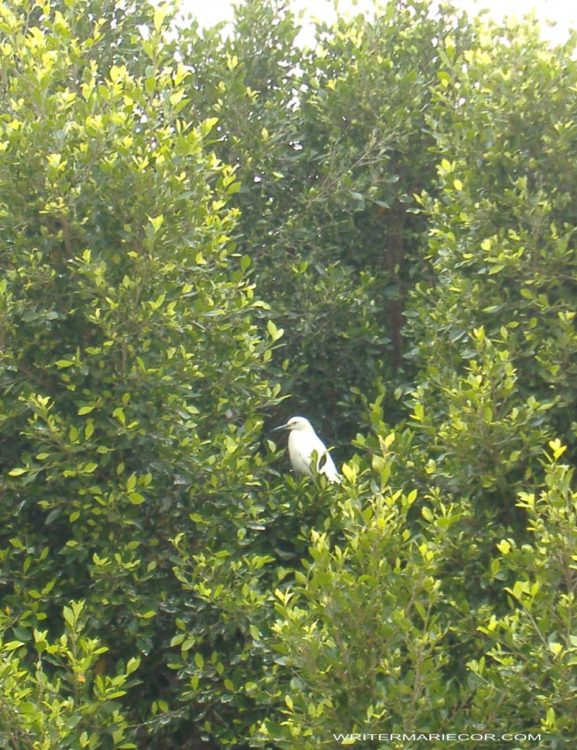The United States Navy has a strong presence on Coronado, California — a city that has historically helped particular bird species populations recover from the brink. One of the USN’s military bases on Coronado, namely the Naval Air Station North Island (NASNI), likewise has programs that strongly advocate bird conservation efforts. Pictured herein are two species of birds that make their home on NASNI.

Pictured above is the black-crowned night heron. Unlike their more elongated cousins, the black-crowned night heron is of stockier build. At resting position, this species tends to be hunched in posture, because it draws in its neck.
Black-crowned night herons tend to feed around dusk and on through to the early morning hours — that way they don’t compete with their cousins, the “day” herons. It’s no surprise then, that the black-crowned night heron’s scientific name, Nycticorax, translates as “night raven.”
Besides that, this bird is known for its feeding technique, called bill vibration. In other words, it will rapidly open and close its bill in the water as a means to lure in prey.
Moreover, black-crowned night herons are a colonial species. A mating pair produces one brood per breeding season, with a clutch of up to 5 eggs. This species reaches full adulthood at three years. Interestingly enough, the young have been described by ornithologists as “aggressive” — for they regurgitate food onto anything or anyone they deem to be a threat.
Pictured above is a juvenile snowy egret. Snowy egrets are small white herons. Ornithologists have reported that snowy egrets tend to prefer urban locations for their nesting grounds — because urban locations have fewer predators.
Pictured above are two snowy egrets. Snowy egrets have recurved plumes on their backs, thus giving them a “shaggy” look. Adults have black bills and yellow lores. Juveniles, on the other hand, have yellowish-green bills with a black tip, and juvenile lores are also yellowish-green. And, just like the black-crowned night heron, the snowy egret is a colonial species, too.
Pictured here, a snowy egret is perched above the tree canopy. In the past, snowy egrets were heavily hunted, because there was a market for their feathers to decorate women’s hats. To get an idea of how much demand there was for them, consider that at one point in time, during the Gilded Age, one ounce of snowy egret plumage cost double the price for one ounce of gold. Consequently, snowy egret numbers were alarmingly decreased to dangerously low levels. This species is now protected by law, which has helped their population rebound.
In this image, a black-crowned night heron and a snowy egret are perched in close proximity to one another. The black-crowned night heron is a social species, even associating with other species of herons, as this photo illustrates. Snowy egrets are also gregarious, and prefer to nest in dense colonies mixed with varied heron species. Safety in numbers is key to the survival of these birds.
A snowy egret reveals his sinuous neck. Snowy egrets are renowned for their spectacular mating displays. Males have been known to be extravagant with their mating behavior. What’s more, snowy egrets can be very vocal, especially during an aggressive encounter.
Herein is another photo of a snowy egret. The plunder of snowy egrets in the 1880s led to public outrage that eventuated in protection, first obtained in 1910. However, their numbers are still susceptible to other threats (e.g. habitat degradation). And, in some parts of the United States, nesting grounds have been abandoned. For this reason, many conservation efforts at state and federal levels have been striving to re-establish and re-colonize snowy egret nesting areas. Some states have even enacted statutes that delineate the minimum distance of approaching a snowy egret so that the bird is not disturbed.
Canopy of eucalyptus trees that serve as nesting grounds for birds; this one is located within Naval Air Station North Island. Black-crowned night herons, after all, are a migrating species, and they roost communally. The same is true of snowy egrets.








Last night around midnight, on some boat docks in Coronado I spotted what appeared to be a blue heron. Is it unusual for this species to be active at that hour? Are there other ‘elongated’ heron species to be found in San Diego other than the great blue?
Hi, Brittany. The blue heron feeds by day in most situations, but nocturnal foraging is also common, especially in tidal habitats. The blue heron, for instance, is known to frequent the shores during early-evening low tides, low tides near midnight, and low tides in the early morning.
And, yes, there are other birds of the heron family that are in San Diego. The Great Egret, the Snowy Egret, and the Cattle Egret are here in San Diego. The Little Blue Heron “arrived” in San Diego in the 1980s, and San Diego now represents the northwest corner of the Little Blue Heron’s usual range. The Tricolored Heron (also known as the Louisiana Heron), meanwhile, is a rare visitor to San Diego; when spotted, it has been seen foraging in the channels through the Tijuana River estuary or in shallow water around south SD Bay. And, the Reddish Egret is only seen as a visitor to San Diego and does not nest here; when spotted, it is usually in the San Diego North County lagoons.
As for the “less-elongated” members of the family, the Green Heron can be found in the northern part of San Diego’s coastal lowland. Then there’s the Black-Crowned Night Heron, which is very common in San Diego year-round. By contrast, the Yellow-Crowned Night Heron is not as ubiquitous. Since 2013, there have been sightings of the Yellow-Crowned Night Heron in only three areas: the San Diego River/SeaWorld, the Tijuana River Valley, and Imperial Beach.
I hope I’ve addressed your questions. You may seek more information from the San Diego Plant Atlas of the San Diego Natural History Museum and even consult further with the seasoned experts at the San Diego Audubon Society: http://www.sandiegoaudubon.org/
Thanks again, Brittany, for stopping by.